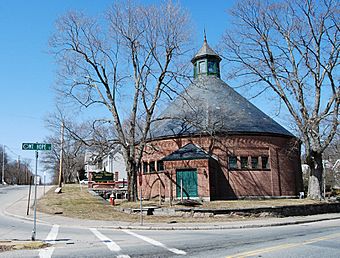Attleborough Falls Gasholder Building facts for kids
Quick facts for kids |
|
|
Attleborough Falls Gasholder Building
|
|
 |
|
| Location | North Attleborough, Massachusetts |
|---|---|
| Area | less than one acre |
| Built | 1882 |
| NRHP reference No. | 96000848 |
| Added to NRHP | August 1, 1996 |
The Attleborough Falls Gasholder Building is a special old building in North Attleborough, Massachusetts. It's a rare example of a gasholder house from the mid-1800s. A gasholder house was a building that held a big tank. This tank stored "coal gas," which was used for lighting and heating before electricity was common.
This historic building was added to the National Register of Historic Places in 1996. This list helps protect important places in the United States.
What is the Attleborough Falls Gasholder Building?
The gasholder building is a round building. It is about 35 feet (11 meters) wide and 32 feet (9.8 meters) tall. It has a cone-shaped roof made of slate. There's also a small, cupola-like top.
A smaller section with a sloped roof sticks out from the main building. The whole building is made of brick. The bricks are laid in a simple pattern called "common bond." It also has fancy brick details like "corbelling" (bricks sticking out) and "pilasters" (flat columns).
How Did the Gasholder Building Work?
Inside the building was a large tank. This tank held gas that was made from coal. This process was called "coal gasification." The gas was then stored in the tank until people needed it.
History of the Gasholder Building
The North Attleborough Gas Company started in 1855. They needed more space to store gas as the town grew. So, in 1882, they built this gasholder building. It was the third one in town.
Next to it was a place where they made the gas from coal. Over time, different companies owned the gas company. In 1940, the building was bought by Roy Underhill. He was an employee of the gas company.
Mr. Underhill saved the building from being torn down. Today, it is still privately owned. It has "preservation restrictions," which means it must be kept safe and protected.



